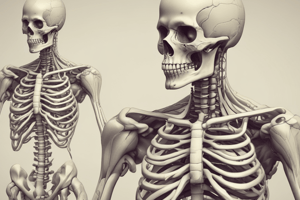Podcast
Questions and Answers
How many bones are humans born with?
How many bones are humans born with?
300
What is the term for being 'towards the head' in anatomical terms?
What is the term for being 'towards the head' in anatomical terms?
Superior
How many main functions do bones have?
How many main functions do bones have?
Five
Which of the following are types of bones? (Select all that apply)
Which of the following are types of bones? (Select all that apply)
What is the primary function of ligaments?
What is the primary function of ligaments?
The appendicular skeleton includes the skull and vertebral column.
The appendicular skeleton includes the skull and vertebral column.
The ______ protects vital organs within the body.
The ______ protects vital organs within the body.
What type of joint allows limited gliding movements?
What type of joint allows limited gliding movements?
Flashcards are hidden until you start studying
Study Notes
Skeletal System Overview
- Humans start with approximately 300 bones at birth, but end up with 206 bones after some fuse together during development, such as those in the skull.
Anatomical Terms
- Superior: Towards the head (e.g., chest is superior to hips).
- Inferior: Towards the feet (e.g., foot is inferior to leg).
- Anterior: Towards the front (e.g., breast is on anterior chest wall).
- Posterior: Towards the back (e.g., backbone is posterior to heart).
- Medial: Towards the midline (e.g., big toe is medial to foot).
- Lateral: Towards the side (e.g., little toe is lateral to foot).
- Proximal: Towards the body's mass (e.g., shoulder is proximal to elbow).
- Distal: Away from the body's mass (e.g., elbow is distal to shoulder).
- Supine: Lying face down.
- Prone: Lying face up.
Major Skeletal Bones
- Long Bones: Characterized by a long shaft and two ends; consist of compact bone on the exterior and spongy bone inside (e.g., femur, humerus).
- Short Bones: Cube-like, primarily composed of spongy bone with a compact bone surface (e.g., carpals, tarsals).
- Flat Bones: Thin, flat bones that often protect organs (e.g., skull, sternum).
- Irregular Bones: Variably shaped bones that do not fit into other categories (e.g., vertebrae, pelvis).
- Sesamoid Bones: Small, round, flat bones found where tendons over joints; protect tendons and improve movement (e.g., patella).
Functions of Bones
- Support: Provide a framework and shape for the body (e.g., vertebrae supporting ribs).
- Protection: Shield vital organs (e.g., pelvis protecting reproductive organs).
- Movement: Work with muscles as levers (e.g., knee joint flexion aiding in kicking).
- Mineral Storage: Store crucial minerals, including calcium.
- Blood Cell Production: Occurs in the cavities of certain bones.
Skeleton Structure
- Axial Skeleton: Comprises skull, ribs, and vertebral column; provides stability and supports the appendicular skeleton's movements; includes mostly immovable bones.
- Appendicular Skeleton: Consists of pelvic girdle, limbs, and shoulder girdle; contains key long bones essential for movement.
Synovial Joints Structure and Function
- Plane Joints: Allow limited gliding movements (e.g., intertarsal joints).
- Hinge Joints: Allow movement along one axis, primarily for flexion/extension (e.g., elbow, knee).
- Pivot Joints: Enable rotational movements (e.g., C1 to C2 vertebral joint).
- Ellipsoid/Condyloid Joints: Permit movement in two planes (e.g., wrist joint).
- Saddle Joints: Similar to condyloid but with no axial rotation (e.g., base of the thumb).
- Ball-and-Socket Joints: Most mobile; allow movement across three planes (e.g., shoulder, pelvis).
Other Joint Types
- Cartilaginous Joints: Joints joined by cartilage allowing slight movement (e.g., between vertebrae).
- Fibrous Joints: Immovable joints connected by fiber (e.g., cranial sutures).
Components of Joints
- Ligaments: Strong bands connecting bones, providing stability by controlling movement.
- Tendons: Tough cords that attach muscles to bones.
- Synovial Fluid: Lubricates joints, providing cushioning and nourishing joint surfaces.
Studying That Suits You
Use AI to generate personalized quizzes and flashcards to suit your learning preferences.




